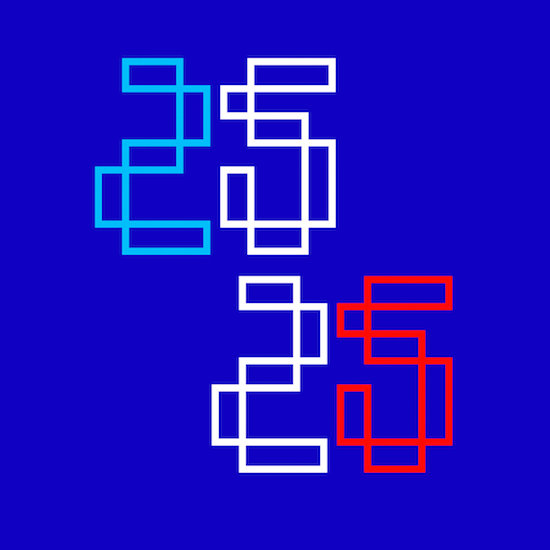Crawling towards you, advancing slowly before eventually seizing you by the collar and giving you a good throttle is the slow onset of ‘Meet Me At the End’ – the opening track of Factory Floor’s 25 25. It escalates gradually, introducing specks of percussion over a relentless, acid-y bassline, before Void’s processed vocals snake in and out of the mix.
Quite a few things have changed for Factory Floor since the release of their eponymous LP. In the three years since, they’ve been whittled down to a duo, left their North London warehouse space and introduced some new modulars and other unfamiliar gear. Though 25 25 is unsurprisingly minimal, each track is packed far tighter than anything on Factory Floor. There’s no time and no space in which to dwell on the absence of Dominic Butler and his SH-101. Don’t mistake this for a dig at Butler: rather, it’s an affirmation of the band’s current manifestation. In their new release, their tightly-knit pairing works to contagious effect.
Suffice to say, the record is repetitive but, despite sounding more mechanical than Factory Floor’s first, 25 25 manages to steer clear of monotony. On first few listens it functions as background noise to daily routine, but 25 25 gradually comes to insist on your attention: it’s more demanding than it lets on at first – more necessary. At this point, it’s not too difficult to try and imagine what it is about the band’s live gigs that inspires attendees to describe them with such visceral, animated language. Or why it is that they’d be booked to play anywhere from The Warehouse Project to the ICA. Or even why it is that other artists seem so keen to work with them (see Carter Tutti Void or their previous residency at the ICA).
25 25 is infectious. It’s every bit as danceable as ‘How You Say’ and ‘Here Again’ off of Factory Floor (the former of which has seen remixes by dance mainstays Helena Hauff and Daniel Avery), but far less relenting. The deliberate quality of each and every sound would almost be surprising for a band that so values the spontaneity of improvisation, if it weren’t by their own admission that they once spent a whole week perfecting a cowbell. Sure, these tracks are derived from jams, but if each tone, each hit and each stutter survived the rounds of ‘ruthless’ editing by Void and Gurnsey, it was kept for a reason. There is a time and place for everything.
The tracks feel more fleshed out than those on the first record, maybe because they now have the space to "let the track breathe for longer" without worrying about driving neighbours insane after subjecting them to endless hours of monotonous kicks. The weight of these tracks are undoubtedly indebted to the duo’s live setup, assembled piece by piece during the making of the record. Thanks should be given, too, to Void’s switch from guitar to modular synths.
Mechanic percussion falls cleanly into place and is made surprisingly groovy in ‘Ya’, the sparse, techno-infused cousin of Yello’s ‘Oh Yeah’. It’s equally infectious and fun with a bit of playfulness to boot (see: plaster synths made by Void in the track’s accompanying music video). Every hi-hat, vocal sample and tom fill has its own particular slot – I imagine this is what a kid’s shape sorting toy would sound like reincarnated as a club tune. The rhythms are so evenly subdivided, you could easily plot them onto a graph, but despite being so perfectly and precisely put together, the album still has space for chaos. It’s orderly and makes a lot of sense, yet there’s space for Gurnsey and Void to throw everything up in the air and see how it falls. These are tracks that will maintain their thrill when given room to run.
‘Relay’ introduces a persistent kick right off the bat, before Void’s vocal samples pan in an almost disorientating manner – stunted, delayed, pitched and layered to trippy effect. The duo have been playing "late night slots" at "clubbier venues" and the influence is perceptible. Four-to-the-floor kicks are heard all around, and none of the tracks clock in at anything under five minutes. Gone are any brief, distorted compositions resembling ‘One’ and ‘Two’ (or cleaner ‘Three’) from the first record. Void’s vocal samples sound like the fragments of yesterday’s night out that you’re now struggling to piece together, accompanied by sparse synth parts that could have been borrowed from a 70s sci-fi movie soundtrack. And if ‘Relay’ is reminiscent of the best/only memories you have of last night, then final track ‘Upper Left’ is the end of it, when you’re losing steam but still trying to persevere. Pitched samples sound like a weird but not unpleasant comedown off of some mystery concoction. It feels a bit more off-kilter than ‘Relay’, but in the most effective and most appropriate way.
Gurnsey’s stated that the band "really started when Void had joined," while Void has said that "Gabe is Factory Floor." In their latest record, it seems quite clear that the partnership is a good fit, as heard in the completed-puzzle of an album. Whether due to Gurnsey and Void’s developing rapport, or the honing of their collective sound, 25 25 packs the immense sort of punch that descriptions of their live shows recount. And given that Void says "this record doesn’t feel like it’s like the ultimate of what we can achieve when we work together as artists," then whatever else they go on to achieve is definitely to be anticipated.
A ‘Slow Listen’ this album is not. If you’re listening, it may swallow you up before spitting you out, leaving you discombobulated and disorientated, limbs akimbo. Best not surrender to it, though at the end of the day, you might not really have a choice.


